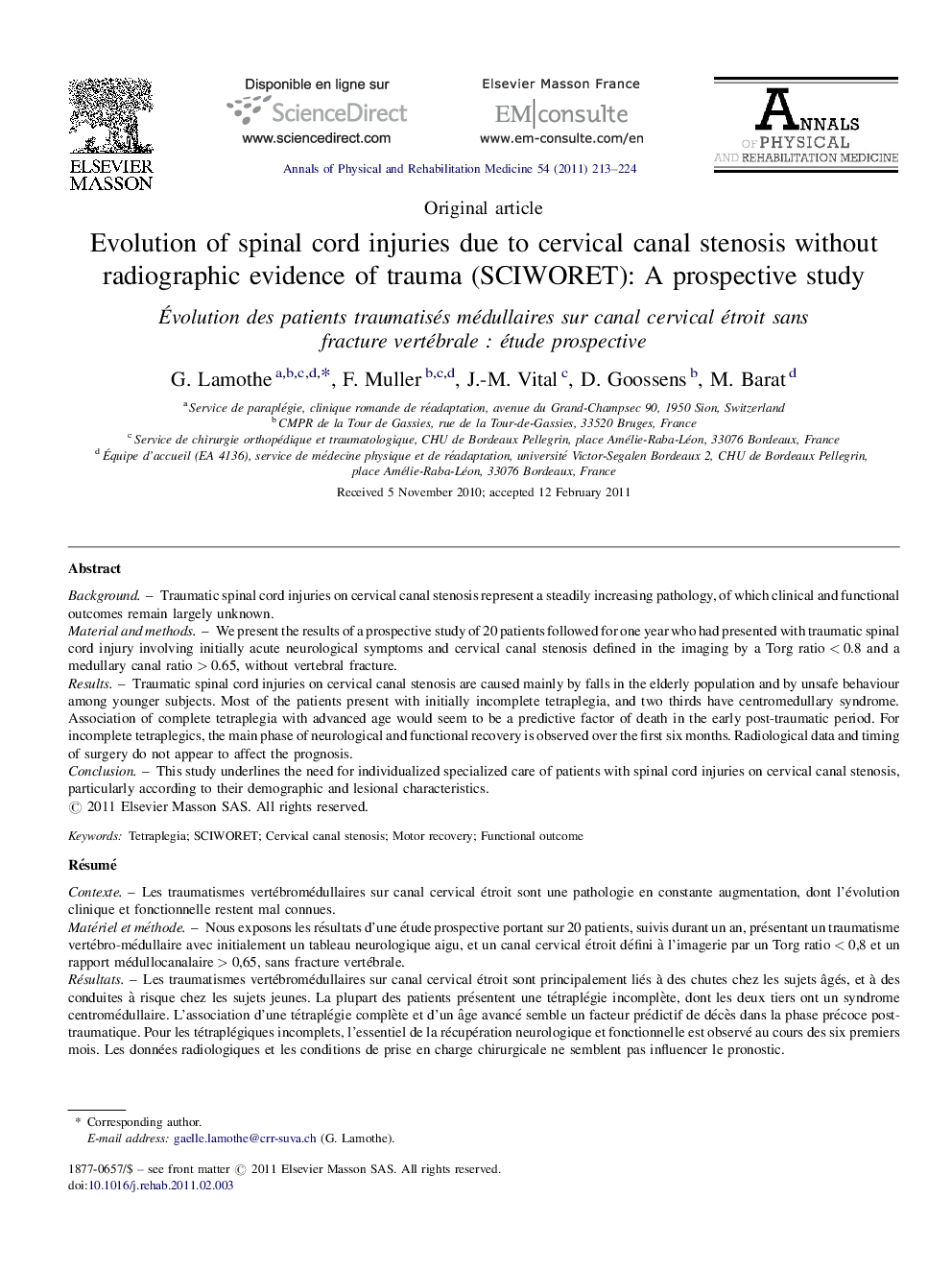| کد مقاله | کد نشریه | سال انتشار | مقاله انگلیسی | نسخه تمام متن |
|---|---|---|---|---|
| 4041255 | 1603337 | 2011 | 12 صفحه PDF | دانلود رایگان |

BackgroundTraumatic spinal cord injuries on cervical canal stenosis represent a steadily increasing pathology, of which clinical and functional outcomes remain largely unknown.Material and methodsWe present the results of a prospective study of 20 patients followed for one year who had presented with traumatic spinal cord injury involving initially acute neurological symptoms and cervical canal stenosis defined in the imaging by a Torg ratio < 0.8 and a medullary canal ratio > 0.65, without vertebral fracture.ResultsTraumatic spinal cord injuries on cervical canal stenosis are caused mainly by falls in the elderly population and by unsafe behaviour among younger subjects. Most of the patients present with initially incomplete tetraplegia, and two thirds have centromedullary syndrome. Association of complete tetraplegia with advanced age would seem to be a predictive factor of death in the early post-traumatic period. For incomplete tetraplegics, the main phase of neurological and functional recovery is observed over the first six months. Radiological data and timing of surgery do not appear to affect the prognosis.ConclusionThis study underlines the need for individualized specialized care of patients with spinal cord injuries on cervical canal stenosis, particularly according to their demographic and lesional characteristics.
RésuméContexteLes traumatismes vertébromédullaires sur canal cervical étroit sont une pathologie en constante augmentation, dont l’évolution clinique et fonctionnelle restent mal connues.Matériel et méthodeNous exposons les résultats d’une étude prospective portant sur 20 patients, suivis durant un an, présentant un traumatisme vertébro-médullaire avec initialement un tableau neurologique aigu, et un canal cervical étroit défini à l’imagerie par un Torg ratio < 0,8 et un rapport médullocanalaire > 0,65, sans fracture vertébrale.RésultatsLes traumatismes vertébromédullaires sur canal cervical étroit sont principalement liés à des chutes chez les sujets âgés, et à des conduites à risque chez les sujets jeunes. La plupart des patients présentent une tétraplégie incomplète, dont les deux tiers ont un syndrome centromédullaire. L’association d’une tétraplégie complète et d’un âge avancé semble un facteur prédictif de décès dans la phase précoce post-traumatique. Pour les tétraplégiques incomplets, l’essentiel de la récupération neurologique et fonctionnelle est observé au cours des six premiers mois. Les données radiologiques et les conditions de prise en charge chirurgicale ne semblent pas influencer le pronostic.ConclusionCette étude souligne la nécessité d’une prise en charge spécialisée et individualisée des patients blessés médullaires sur canal cervical étroit, notamment selon leurs caractéristiques démographiques et lésionnelles.
Journal: Annals of Physical and Rehabilitation Medicine - Volume 54, Issue 4, June 2011, Pages 213–224